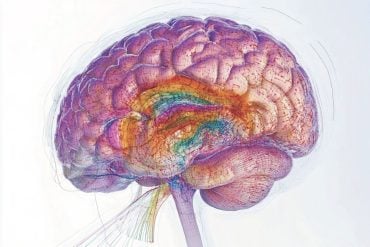Summary: Study reports on surprising link between chronic constipation and the herpes simplex virus.
Source: Yale.
A Yale-led study has shown a surprising link between constipation and herpes infection. The finding, published June 8 in Cell Host & Microbe, advances the science on herpes, and could help patients with chronic gastrointestinal diseases with no clear cause.
Individuals with herpes have reported seemingly unrelated symptoms such as constipation and urinary retention (inability to empty the bladder), but the mechanism was not understood. The research team, led by Akiko Iwasaki, professor of immunobiology and Howard Hughes Medical Institute investigator, decided to investigate using mice models of herpes simplex virus-1, the dominant cause of genital herpes in the United States.

They found that the herpes virus spread from the genitals to nerves in the spinal cord, and then on to neurons in the colon, killing them. The damage to the colonic neurons prevented the movement of food along the digestive tract, leading to an enlarged colon and disease.
While the effects in mice are distinct from what happens in people with herpes, the study reveals a previously unrecognized disease process. “The key findings is that there is this unexpected infection in the neurons in the colon wall after herpes infection,” said Iwasaki. “Other members of the herpes virus family, including Epstein-Barr virus, chicken pox virus, and cytomegalovirus have been found in the neurons of the colon of people with unexplained chronic constipation. When doctors can’t figure out the cause of these chronic intestinal conditions, one thing to look at is a viral infection.”
Other study authors include William Khoury-Hanold, Brian Yordy, Philip Kong, Yong Kong, William Ge, Klara Szigeti-Buck, Alexandra Ralevski, and Tamas L. Horvath.
Funding: This research was supported by the Howard Hughes Medical Institute and the National Institutes of Health.
Source: Ziba Kashef – Yale
Image Source: This NeuroscienceNews.com image is credited to William Khoury-Hanold.
Original Research: Abstract for “Viral Spread to Enteric Neurons Links Genital HSV-1 Infection to Toxic Megacolon and Lethality” by William Khoury-Hanold, Brian Yordy, Philip Kong, Yong Kong, William Ge, Klara Szigeti-Buck, Alexandra Ralevski, Tamas L. Horvath, and Akiko Iwasaki in Cell Host & Microbe. Published online June 8 2016 doi:10.1016/j.chom.2016.05.008
[cbtabs][cbtab title=”MLA”]Yale. “Study Find a Surprising Cause For Constipation.” NeuroscienceNews. NeuroscienceNews, 8 June 2016.
<https://neurosciencenews.com/constipation-herpes-spinal-cord-4412/>.[/cbtab][cbtab title=”APA”]Yale. (2016, June 8). Study Find a Surprising Cause For Constipation. NeuroscienceNews. Retrieved June 8, 2016 from https://neurosciencenews.com/constipation-herpes-spinal-cord-4412/[/cbtab][cbtab title=”Chicago”]Yale. “Study Find a Surprising Cause For Constipation.” https://neurosciencenews.com/constipation-herpes-spinal-cord-4412/ (accessed June 8, 2016).[/cbtab][/cbtabs]
Abstract
Viral Spread to Enteric Neurons Links Genital HSV-1 Infection to Toxic Megacolon and Lethality
Highlights
•HSV-1-associated lethality in mice correlates with severe fecal and urinary retention
•HSV-1 spreads from nociceptors in the vagina to the enteric nervous system (ENS)
•Viral replication in the ENS leads to inflammation and neutrophil recruitment
•Neutrophil-mediated destruction of the ENS leads to lethality from genital herpes
Summary
Herpes simplex virus 1 (HSV-1), a leading cause of genital herpes, infects oral or genital mucosal epithelial cells before infecting the peripheral sensory nervous system. The spread of HSV-1 beyond the sensory nervous system and the resulting broader spectrum of disease are not well understood. Using a mouse model of genital herpes, we found that HSV-1-infection-associated lethality correlated with severe fecal and urinary retention. No inflammation or infection of the brain was evident. Instead, HSV-1 spread via the dorsal root ganglia to the autonomic ganglia of the enteric nervous system (ENS) in the colon. ENS infection led to robust viral gene transcription, pathological inflammatory responses, and neutrophil-mediated destruction of enteric neurons, ultimately resulting in permanent loss of peristalsis and the development of toxic megacolon. Laxative treatment rescued mice from lethality following genital HSV-1 infection. These results reveal an unexpected pathogenesis of HSV associated with ENS infection.
“Viral Spread to Enteric Neurons Links Genital HSV-1 Infection to Toxic Megacolon and Lethality” by William Khoury-Hanold, Brian Yordy, Philip Kong, Yong Kong, William Ge, Klara Szigeti-Buck, Alexandra Ralevski, Tamas L. Horvath, and Akiko Iwasaki in Cell Host & Microbe. Published online June 8 2016 doi:10.1016/j.chom.2016.05.008






